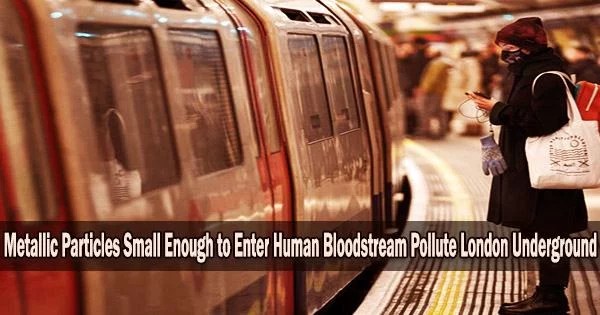Researchers from the University of Cambridge claim that the London Underground is contaminated with tiny metallic particles that are small enough to enter a person’s bloodstream. Since these particles are so minute, it’s possible that surveys of the pollution in the oldest metro system in the world are underestimating their presence.
The scientists used magnetism to analyze dust samples collected from Underground ticket halls, stations, and operator cabins as part of a novel sort of pollution analysis.
The scientists discovered that a form of iron oxide known as maghemite was present in significant amounts in the samples. The findings imply that poor ventilation throughout the Underground, particularly on station platforms, is to blame for pollution particles being trapped for extended periods of time since iron takes time to oxidize into maghemite.
Small enough to be breathed and enter the bloodstream, but too small to be detected by conventional methods of pollution monitoring, some of the particles have a diameter of only five nanometers. However, it is not clear whether these particles pose a health risk.
This is the first time that the size and kind of particles have undergone a thorough analysis. Other studies have examined the overall pollution levels on the Underground and the health hazards related to them.
The researchers propose that frequent dust cleaning from underground tubes and magnetic monitoring of pollution levels could enhance the network’s air quality. Their results are reported in the journal Scientific Reports.
The London Underground carries five million passengers per day. Numerous studies have demonstrated that air pollution levels on the Underground are higher than those in London as a whole and exceed World Health Organization’s (WHO) established standards.
According to earlier research, the wheels, rails, and brakes on the Underground produce the majority of the microscopic, iron-rich particles that make up the particulate pollution.
Our techniques give a much more refined picture of pollution in the Underground. We can measure particles that are small enough to be inhaled and enter the bloodstream. Typical pollution monitoring doesn’t give you a good picture of the very small stuff.
Professor Richard Harrison
“Since most of these air pollution particles are metallic, the Underground is an ideal place to test whether magnetism can be an effective way to monitor pollution,” said Professor Richard Harrison from Cambridge’s Department of Earth Sciences, the paper’s senior author. “Normally, we study magnetism as it relates to planets, but we decided to explore how those techniques could be applied to different areas, including air pollution.”
Standard air filters are typically used to measure pollution levels, however they are unable to catch ultrafine particles and cannot tell what types of particles are contained in the particulate matter.
“I started studying environmental magnetism as part of my PhD, looking at whether low-cost monitoring techniques could be used to characterise pollution levels and sources,” said lead author Hassan Sheikh from Cambridge’s Department of Earth Sciences. “The Underground is a well-defined micro-environment, so it’s an ideal place to do this type of study.”
Sheikh and Harrison examined 39 dust samples from the London Underground provided by Transport for London (TfL) while working with colleagues from Cambridge’s Department of Materials Science and Metallurgy.
The Piccadilly, Northern, Central, Bakerloo, Victoria, Northern, District, and Jubilee lines were the locations where the samples were taken in 2019 and 2021 from platforms, ticketing areas, and train operator cabins. Major stations like King’s Cross St. Pancras, Paddington, and Oxford Circus were included in the sampling.
To describe the structure, size, shape, composition, and magnetic properties of the particles present in the samples, the researchers used magnetic fingerprinting, 3D imaging, and nanoscale microscopy.
The Cambridge team was able to examine the pollution in the Underground in considerably more detail than previous research, which had previously showed that 50% of the particles are iron-rich. They discovered a significant number of maghemite particles, with an average diameter of 10 nanometers and a diameter range from 5 to 500 nanometers. Some particles organized into larger clusters that ranged in size from 100 to 2,000 nanometers.
“The abundance of these very fine particles was surprising,” said Sheikh. “The magnetic properties of iron oxides fundamentally change as the particle size changes. In addition, the size range where those changes happen is the same as where air pollution becomes a health risk.”
Although the researchers did not examine whether these maghemite particles directly endanger human health, they claim that their characterization techniques may be helpful in subsequent investigations.
“If you’re going to answer the question of whether these particles are bad for your health, you first need to know what the particles are made of and what their properties are,” said Sheikh.
“Our techniques give a much more refined picture of pollution in the Underground,” said Harrison. “We can measure particles that are small enough to be inhaled and enter the bloodstream. Typical pollution monitoring doesn’t give you a good picture of the very small stuff.”
According to the researchers, the air quality on platforms can be worse than in ticket halls or operator cabins because of the Underground’s inadequate ventilation, which can cause iron-rich dust to be resuspended in the air when trains arrive at platforms.
The researchers propose that an effective removal technique might include magnetic filters in ventilation, cleaning of the tracks and tunnel walls, or installing screen doors between platforms and trains due to the magnetic nature of the resuspended dust.
The research was supported in part by the European Union, the Cambridge Trust and Selwyn College, Cambridge.
















